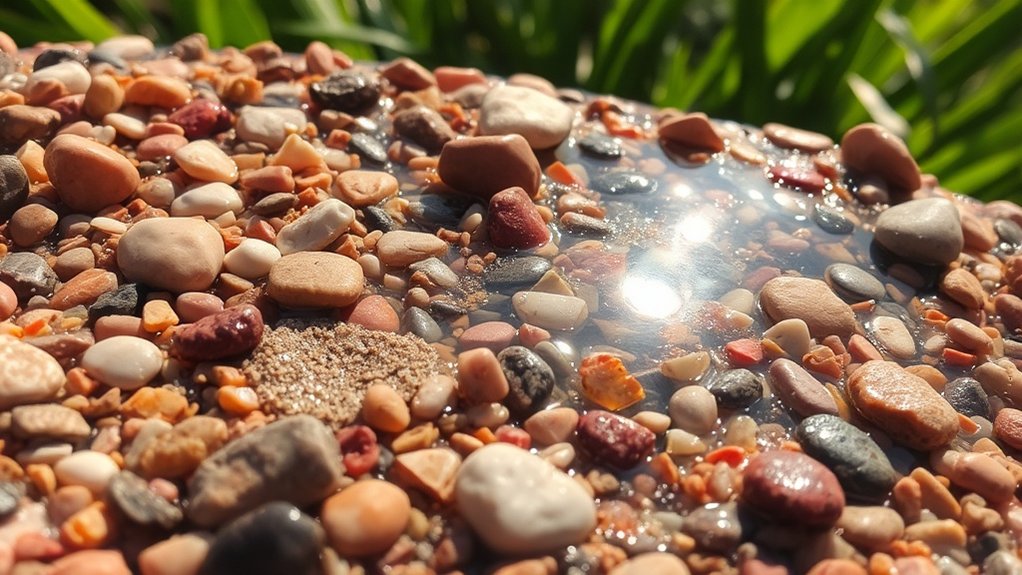The quality of aggregate significantly influences the lifespan of resin-bound gravel surfaces. Using high-quality, well-graded aggregates ensures a strong bond with the resin, which enhances durability and lowers maintenance requirements. The size and shape of the aggregates also play a crucial role in drainage and permeability, aiding effective water management. Moreover, the type of aggregates selected affects the surface texture and slip resistance, which are important for safety and aesthetics. By understanding these elements, you can make informed choices about aggregates that will improve both longevity and performance.
Key Takeaways
- High-quality aggregates boost the durability and lifespan of resin-bound gravel surfaces by providing stability and resistance to wear from the elements.
- The right mixing ratio, along with the quality of aggregates, is crucial for the strength and longevity of resin-bound gravel installations.
- Well-graded aggregates enhance drainage and permeability, reducing water pooling that can damage the resin over time.
- The shape and texture of aggregates play a significant role in mechanical interlocking, improving the bond with the resin and prolonging the surface’s lifespan.
- Regular maintenance and inspection of aggregate surfaces help spot problems early, enhancing the overall durability of resin-bound gravel.
Importance of Aggregate Quality in Resin-Bound Systems
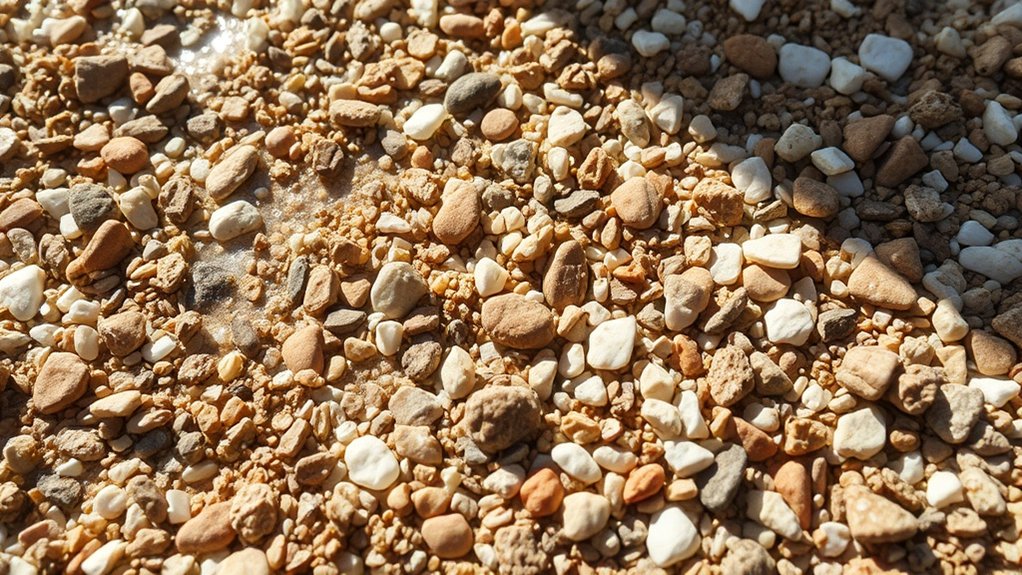
When choosing aggregates for resin-bound systems, it’s crucial to prioritise quality, as this directly affects the surface’s performance and durability. High-quality aggregates improve longevity by providing resistance to weather, load, and erosion. Consider options like natural stone or recycled glass, each offering unique durability and aesthetic benefits. It’s important to ensure a well-distributed grain size for stability and to select chemically stable aggregates that can withstand environmental wear. Additionally, using aggregates for resin bound gravel ensures effective water drainage, which further enhances the lifespan of the surface. Properly graded aggregates improve bonding strength and create a tighter fit for a more durable installation. Also, check for compatibility with the substrate to ensure a strong base for the resin-bound system. By focusing on aggregate quality, you can reduce maintenance needs and extend the surface’s lifespan, resulting in a reliable and attractive installation for years to come.
Bonding Performance Between Resin and Aggregate
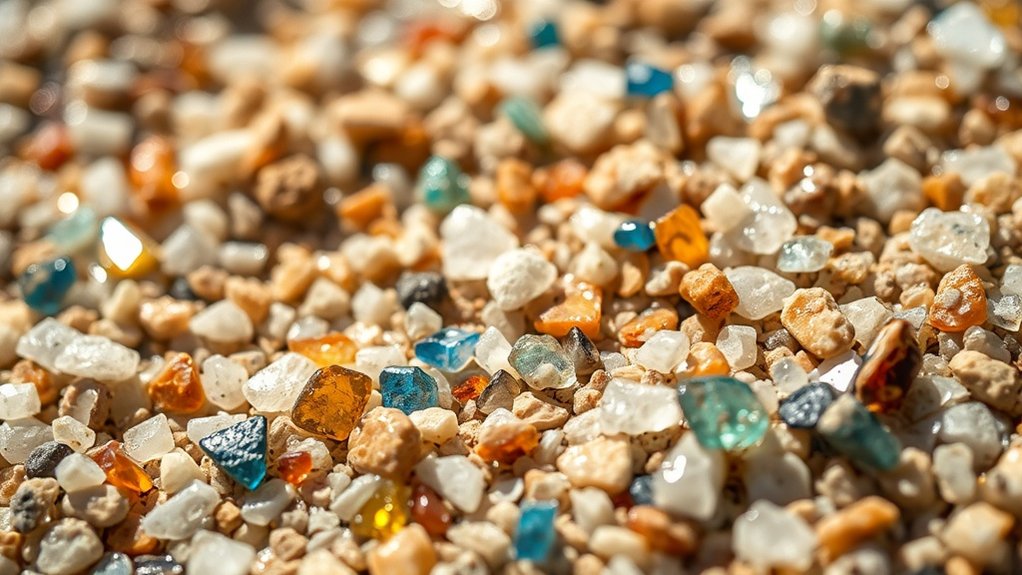
When assessing the bonding performance between resin and aggregate, the mixing ratio is crucial for ensuring strength and durability. An incorrect ratio can weaken the structure or leave the aggregate exposed, which can jeopardise the bond. Recognising the limitations of chemical bonding highlights the importance of mechanical interlocking for optimal performance. For instance, using the right proportions can significantly enhance the resilience of a floor coating in a busy warehouse. Additionally, the longevity of resin-bound paving is directly influenced by the quality of the aggregate used in the mixture. Since the choice of aggregate affects the appearance and longevity of resin-bound gravel projects, ensuring proper drainage and wear resistance is essential.
Mixing Ratios Importance
Achieving optimal bonding between resin and aggregate relies on the correct resin-to-aggregate mixing ratios. Ideal resin levels, typically between 7-15% by weight, are crucial for ensuring durability and stability. A mix of aggregate sizes can also allow for lower resin ratios, which improves surface strength. Using a reliable forced action mixer is essential for achieving uniform resin coverage and ensuring the quality of the final product. Additionally, preparation of the solid base ensures effective bonding and longevity of the system.
| Mixing Aspect | Impact on Bonding |
|---|---|
| Insufficient Resin | Leads to weak, unstable surfaces |
| Excessive Resin | Causes brittleness and cracking |
| Forced Action Mixer | Ensures uniform resin coverage |
| Consistent Mixing Time | Prevents colour inconsistencies |
Utilising effective mixing techniques and adhering to time guidelines helps create a consistent mix, enhancing bonding and the longevity of your resin-bound gravel.
Chemical Bonding Strength
Ideal mixing ratios are crucial for effective chemical bonding between resin and aggregate. However, the strength of this bond depends significantly on the resin’s chemical properties and the preparation of the aggregates.
Using high-quality epoxy resin boosts bonding strength due to its polymerisation process, which creates strong cross-links. Be cautious, though; moisture and dust on aggregates can compromise this bond.
To ensure optimal chemical bonding, choose consistent and clean aggregate types and prepare surfaces properly. Correct grading and sizing of aggregates also contribute to uniform bonding.
Ultimately, understanding these interactions enhances the structural integrity and longevity of resin-bound surfaces, making careful selection and preparation vital.
Impact of Aggregate on Drainage and Permeability
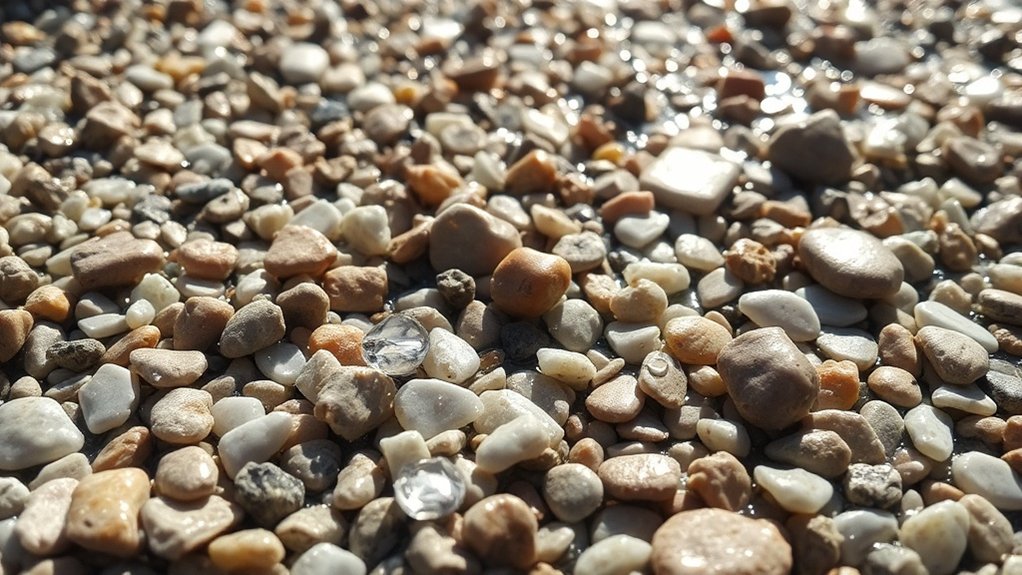
When choosing aggregates for resin-bound gravel, the size distribution plays a crucial role in drainage and permeability. A well-graded mix of different sizes improves water flow by creating suitable voids, allowing water to pass through efficiently.
In contrast, using uniform or overly fine aggregates can block these pathways, leading to reduced drainage effectiveness. For instance, think of it like a sieve: larger stones create spaces for water to escape, while smaller particles can clog those spaces.
Aggregate Size Distribution
Aggregate size distribution is crucial for the drainage and permeability of resin-bound gravel systems. By optimising the sizes of aggregates, such as combining 1-3mm and 2-5mm stones, you can create a mix that interlocks effectively. This enhances mechanical strength and drainage.
Proper gradation reduces the amount of fines, allowing water to flow freely through the mix, which prevents clogging and aids in efficient runoff management.
The shape of the particles—whether rounded or angular—also impacts packing density and permeability. A well-distributed aggregate mix supports sustainable urban drainage systems (SUDS) by facilitating rapid water infiltration.
On the other hand, oversized or poorly graded aggregates can lead to uneven surfaces and hinder drainage pathways. Striking the right balance is essential for prolonging the lifespan of the resin-bound surface.
Water Filtration Ability
Several factors affect the water filtration capability of resin-bound gravel systems, with the type and composition of the aggregates being crucial.
Choosing the right aggregates can significantly improve water flow and filtration efficiency. Here are some key points to consider:
- Porosity: Natural aggregates allow around 95% of rainwater to pass through, aiding drainage.
- Composite Structure: These aggregates form a filtration layer that traps debris and ensures a steady water flow.
- Size Variety: Using aggregates of different sizes increases the gaps between particles, enhancing stability and drainage efficiency.
Surface Texture and Slip Resistance Influenced by Aggregate
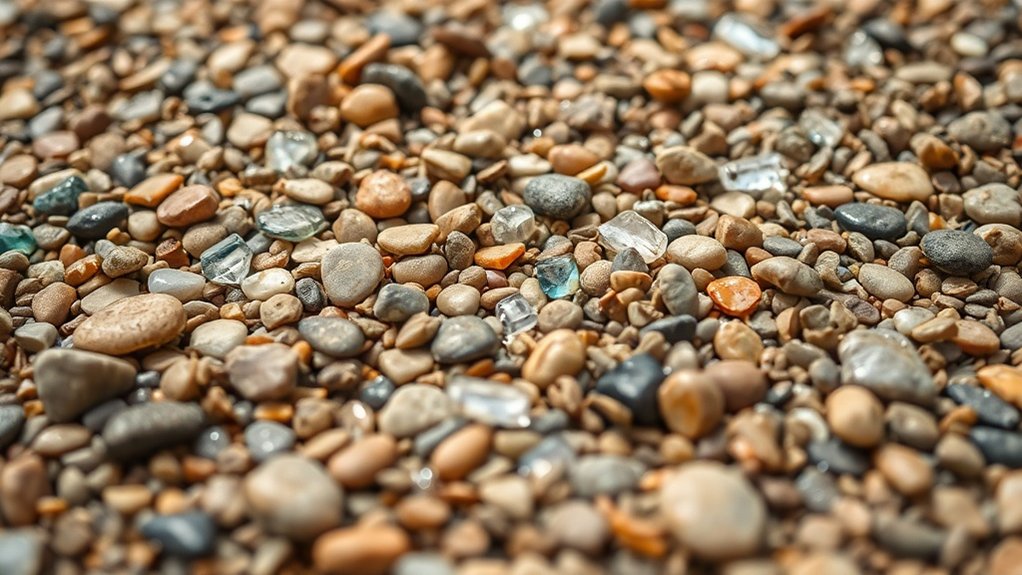
The surface texture of resin-bound gravel is vital for its slip resistance, heavily influenced by the choice of aggregate. The shape of the aggregate plays a significant role in traction; irregular shapes offer better slip resistance due to improved surface interlocking. Variations in texture, determined by the size and shape of the aggregate, enable custom surfaces that cater to both aesthetic appeal and safety requirements.
| Aggregate Type | Surface Texture | Slip Resistance Level |
|---|---|---|
| 1-3mm Rounded | Smooth | Low |
| 2-5mm Angular | Varied | Medium |
| 5-8mm Irregular | Rugged | High |
| Mixed Shapes | Textured | Very High |
| Fine Aggregate | Smooth | Low |
Selecting the appropriate aggregate ensures a durable and visually pleasing surface while enhancing safety.
Maintenance and Repair Needs Related to Aggregate Durability
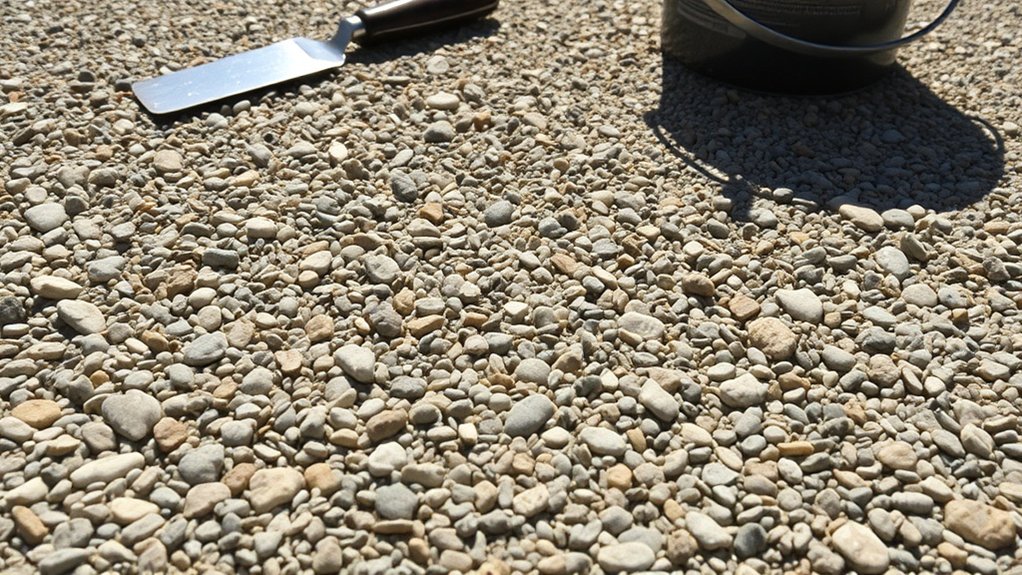
Choosing the right aggregate affects not just surface texture and slip resistance, but also the maintenance and repair requirements. High-quality aggregates reduce wear and the frequency of maintenance by boosting durability and resistance to environmental stresses.
To ensure longevity, consider these maintenance practices:
- Regularly sweep to remove debris and prevent it from embedding.
- Use gentle pressure washing to clean the surface without dislodging stones.
- Inspect for loose areas and address any issues promptly to avoid escalation.
Environmental Considerations in Aggregate Selection
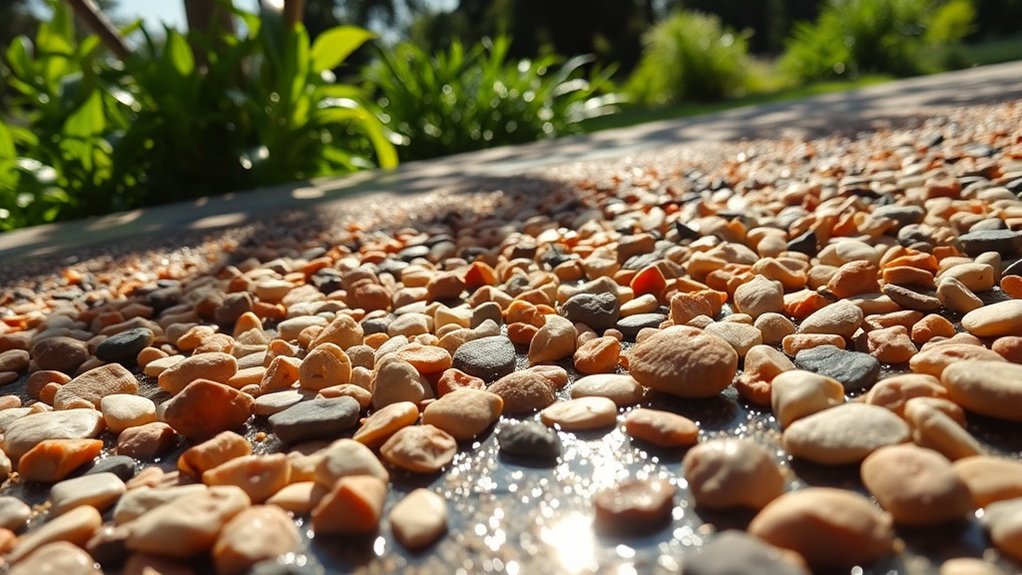
When choosing aggregates for resin-bound gravel, consider the environmental impact on performance and durability.
Extraction and processing can damage landscapes, disrupt ecosystems, and raise carbon emissions. Using sustainable sources, like recycled aggregates, reduces landfill waste and conserves natural resources.
In areas with high rainfall, select aggregates with low water absorption to maintain resin strength, while in drier regions, moisture-retaining aggregates are beneficial.
Aggregate’s Role in Aesthetic Appeal and Longevity

The aesthetic appeal of resin-bound gravel surfaces hinges largely on the choice of aggregates, which significantly impacts both visual outcome and durability.
Selecting the right aggregates not only allows for colour customisation but also ensures that the surface retains its appearance over time.
Key considerations include:
- Aggregate shape: Rounded stones create a smooth finish, while angular stones lend a more rugged texture.
- Colour variety: A diverse range of colours enables designs that harmonise with different architectural styles.
- Colour stability: Consistent colour helps prevent fading, ensuring the surface maintains its visual integrity for many years.
Selecting the Right Aggregate for Optimal Performance

The performance of resin-bound gravel surfaces hinges on the right choice of aggregates, which affects durability, stability, and overall functionality.
For optimal results, select aggregates sized between 2 mm and 10 mm to enhance permeability and achieve a smooth finish. Ensure your aggregates are clean and dry; moisture and dust can weaken the resin bond and shorten the lifespan of the surface.
During processing, screen out fines and inconsistencies to maintain uniform grading, preventing segregation during mixing. Hard-wearing materials like granite or quartz are recommended for better wear resistance.
Additionally, consider the colour and texture, as these can influence thermal performance. Following these guidelines will significantly boost the longevity and visual appeal of your resin-bound gravel surfaces.
Frequently Asked Questions
How Does Aggregate Choice Affect Resin-Bound Gravel Installation Costs?
Your choice of aggregate significantly impacts the costs of resin-bound gravel installation. Premium aggregates often need specialised labour and additional preparation, which can drive up expenses. In contrast, using locally sourced materials tends to lower overall project costs and simplifies the process. For example, opting for a local gravel type can save you both time and money compared to importing more exotic options.
Can Aggregate Type Influence Color Variations in Resin-Bound Surfaces?
Yes, the type of aggregate significantly affects the colour stability and visual appeal of resin-bound surfaces. Different aggregates can produce a range of shades and textures, resulting in vibrant, durable colours that enhance the overall look while being resistant to environmental factors. For instance, using a darker aggregate can create a striking contrast against lighter resin, making driveways or patios more visually interesting.
What Aggregates Are Best for Hot Climates?
For hot climates, opt for heat-resistant aggregates like crushed stone and lighter-coloured options to improve reflectivity. Aggregates that retain moisture can aid drainage, reducing heat absorption and helping to maintain surface integrity during extreme temperatures.
How Do Aggregate Sizes Affect Installation Time?
Smaller aggregates can cut installation time by as much as 20% thanks to greater efficiency. However, they need precise mixing and careful layering, which could negate these time savings if not managed correctly. For instance, if you’re laying a driveway, using smaller stones might speed things up, but if they aren’t mixed properly, you could end up having to redo sections, wasting time.
Are There Specific Aggregates That Reduce Environmental Impact?
Yes, sourcing local natural aggregates sustainably and using recycled materials, such as crushed glass, can significantly lower environmental impact. This method reduces transportation emissions and supports resource recovery, in line with circular economy principles. For instance, using recycled glass in concrete not only diverts waste from landfill but also enhances the material’s strength. Overall, these practices promote sustainability in construction.
Conclusion
In summary, the quality of aggregate is crucial for the lifespan of resin-bound gravel systems. Choosing the right aggregate ensures proper bonding, effective drainage, and good slip resistance, all of which enhance performance and durability. For instance, a high-quality aggregate can prevent issues like cracking or sinking, which can be costly to repair. Think about how your choice affects maintenance and appearance—would you sacrifice durability for looks? Ultimately, selecting the right aggregate not only improves functionality but also creates a sturdy and attractive surface that lasts.
